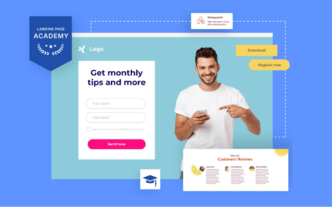Before you launch a test, you should set up a goal. Usually, it will be the same as a landing page goal, but they may differ sometimes.
The most popular A/B test goal is increasing the conversion rate. But how to determine which part of a landing page is responsible for the underperforming conversion? You can go back to Lesson 1 of this chapter – I've written about finding the pain points there.
The same goes for the bounce rate. If it's too high, you should optimize the first section of a landing page or take a step back and focus on an advertisement that directs to the landing page – it, too, can be A/B tested.
If you run an eCommerce business, your focus is most likely on more purchases. Optimizing a landing page for sales may be more demanding than just A/B testing its headline. There might be a problem with the form, but also with payment gateways or the offer itself. Try different approaches, integrate your landing page with more payment options, focus on benefits – do they fit the target audience's expectations?
Another goal of the A/B test may be getting better leads. It's usually all about the form. You can quickly test the form by adding a field and getting more data. Why shouldn’t you add it without the test? Because asking people to share more information about them may hurt your conversions.













